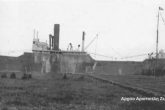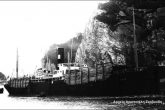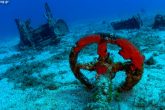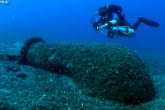Shipwreck S/S Oria
Steamship Oria
The wreck of the steamship “Oria” at Gaidouronisi, a tragedy that took place during the German Occupation of Greece in February 1944 and had almost the triple number of victims in comparison to the wreck of Titanic, is forgotten and left in the past of the History. Only few know that more than 4000 Italian prisoners died in the Saronic Gulf when – according to the most known version – the steamship, commanded by the Germans, due to a nautical mistake and the bad weather, crashed into the rocky islet of Gaidouronisi, also known as Patroklos, near Sounio, overturned and sank within almost two days, taking into the wet grave and the historical oblivion thousands of unlucky Italian soldiers that were locked in the hold of the ship.
“Since 1996 I had some information by fishermen that were catching in their nets billycans and other war material by an unknown wreck located southeast of the island of Patroklos and in combination with the references of an old diver that had described a place of debris at the same area we started our researches in 1999”, says Mr. Aristotelis Zervoudis, professional diver and historian who follows for the last 10 years the traces of this tragic disaster. Mr. Aristotelis Zervoudis says that “Even today, after a decade of researching this wreck, its identification and many divings in it, it is still impossible for me to realize the size of the tragedy; the number of 4115 victims is just incredible.”
Mr. Dimitris Galon, historian musicologist and amateur diver presents the results of his research after a toilsome search in the archives of that period: “According to the first German references the Norwegian captain and 14 German soldiers were saved from the aground ship that was still crashing on the rocks due to the waves and the wind. According to the later Italian sources 21 Italian prisoners, 6 German soldiers and one Greek crew member mariner were saved. The 4100 Italian prisoners, the rest German soldiers and the crew of “Oria” were lost forever in the Aegean Sea. Many months after the wreck and dead bodies were still beaching off the near coasts. A part of the Italian army of the Dodecanese that was delivered to the German army after the capitulation of Italy in autumn 1943 was meant to be lost tragically, leaving its last marks in the Greek sea bottom.
The causes of the wreck
The reference of the captain Mr. Heinrich Rolman of the German Nautical Administration of Attiki at the War Diary of his department in February 13th 1944 mentions that “a convoy consisted of the ships ΤΑ 16, ΤΑ 17, ΤΑ 19 and the steam ship Oria with almost 4000 Italian prisoners coming from Rodes passed by Sounio. While the escorting ships were struggling against the storm and the big waves, Oria crashed into Gaidouronisi with many human losses. For now, no help can be sent due to the unusual big waves.”
The big number of victims as well as the way that the ship sank forced the German military administration to conduct inquiries to examine the causes of this disaster that had so many victims. The conclusion mentions that responsible for the wreck were the bad weather conditions as well as the wrong handling of the Norwegian captain Mr. Bjarne Rasmussen and the impossibility of sending immediately the lifeboats that could help some of the survivors that were trapped in the hold of the overturned “Oria”.
Another version, that cannot be confirmed though by other independent sources, mentions that the ship either crashed into a mine that had escaped its anchorage or was hit by a submarine torpedo. “I think that there was no deceit by the German occupation army regarding this fact that maybe is the biggest marine tragedy in the Greek seas due to the big number of victims. The significant lack of raw materials, and consequently the lack of ships, forced the German occupation army to use the only ships that had in the Greek seas, i.e some commanded old cargo steamships that with some constructive changes had been transformed into locomotive traversers. Many of these ships sank with many Italian prisoners on them by air or submarine attacks of the British army while they were sailing towards Piraeus.
In the case of “Oria”, the explanation of the disaster based on facts is almost impossible due to lack of testimonials and independent sources. The only information that is in our disposal for a slight try to explain this tragic fact is the details from the German archives, some information from the Italian archives and whatever has been reported all this time from the media. However, what we really miss is the valuable testimonials of the few witnesses that survived”, explains Mr. Galon.
The most tragic part of this wreck is the fact that the overturned ship did not sink immediately, prolonging in this way the anxiety of all these people that were waiting to die as the air was decreasing and the waters were coming into the hold. Some of the personal belongings of the soldiers that were detected by the fishermen nets in the next years had carved on them their names as well as their last messages to their families as they were waiting to die.
After the war
In the tortured by the Occupation and the Civil War Greece during the first years of the 50s, we could find almost everywhere debris and war material from the wrecks that could be sold to the steel mills. Unfortunately, this was the destiny of “Oria” too, despite the fact that today is considered to be a wet grave and a monument of 4000 people that should have remained untouchable as a tribute to the memory of the victims.
Today
Many amateur divers visit today the remaining of the wreck even though they cannot see anything more than some curved beams, barrels from the ship’s cargo and bones spread all over the place as silent witnesses of this tragedy that affected thousands of people.
Pierre Kosmidis
(Newspaper “Eleftheros Tipos”)








